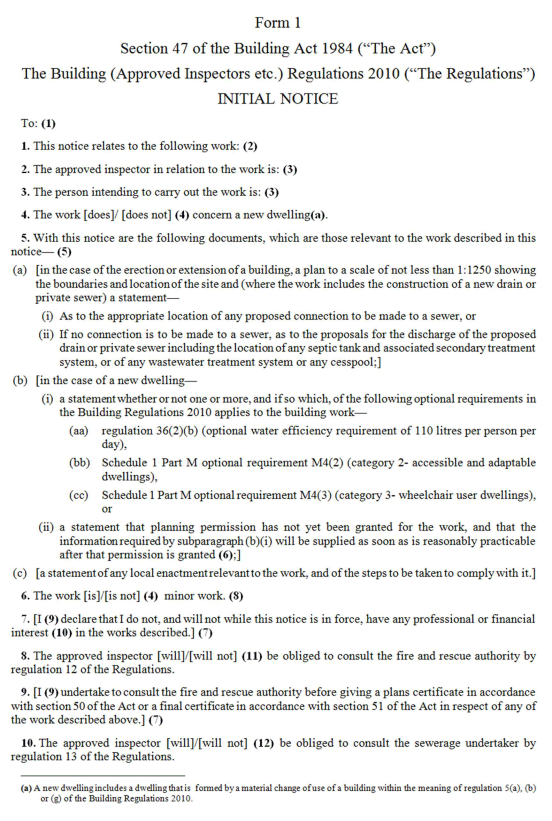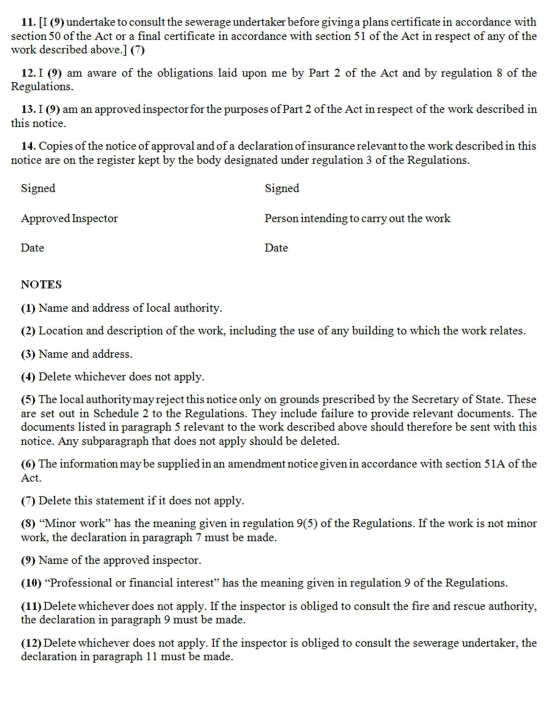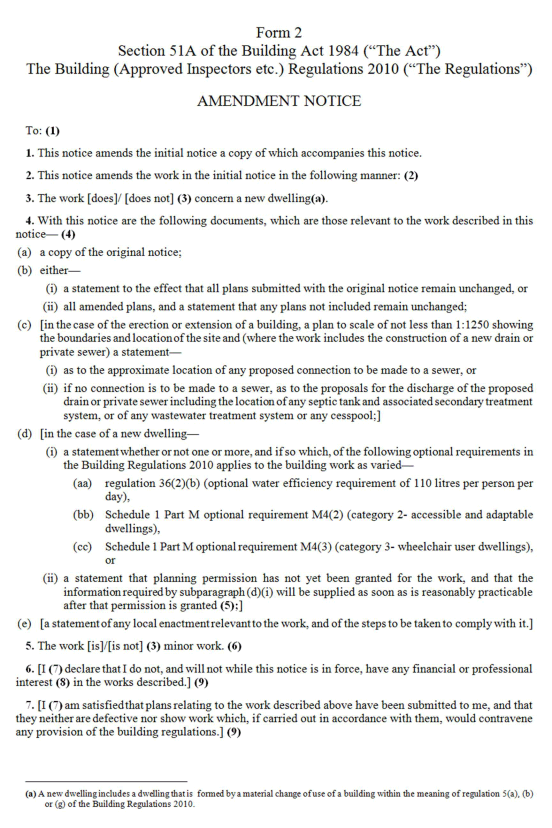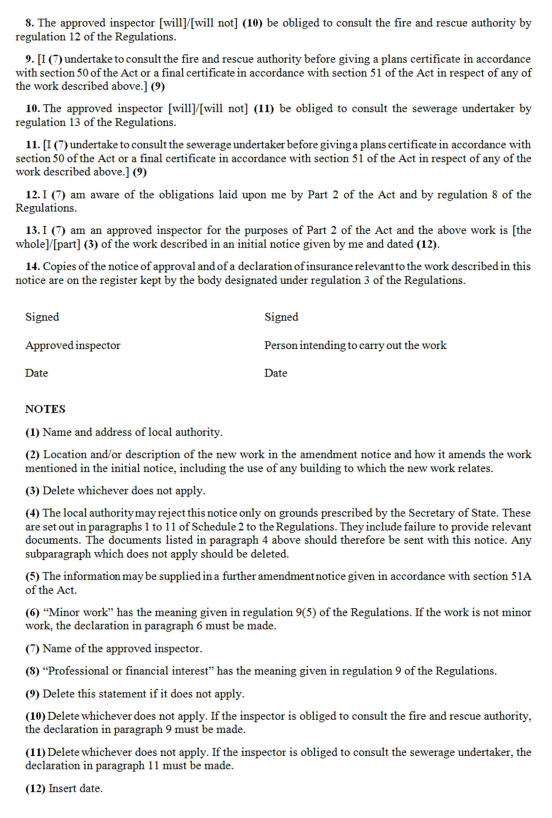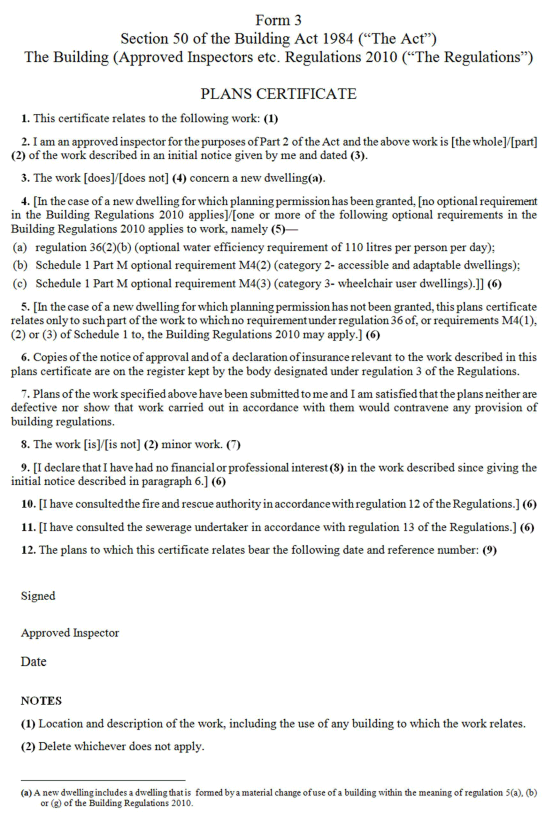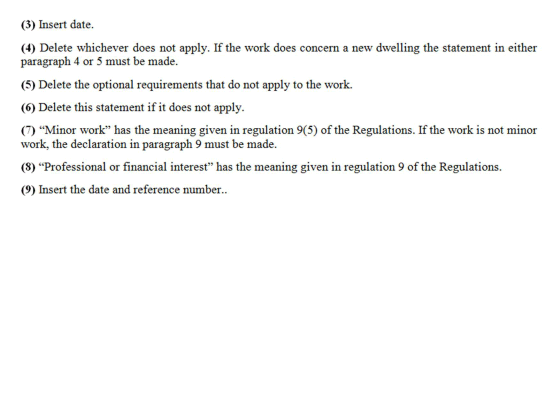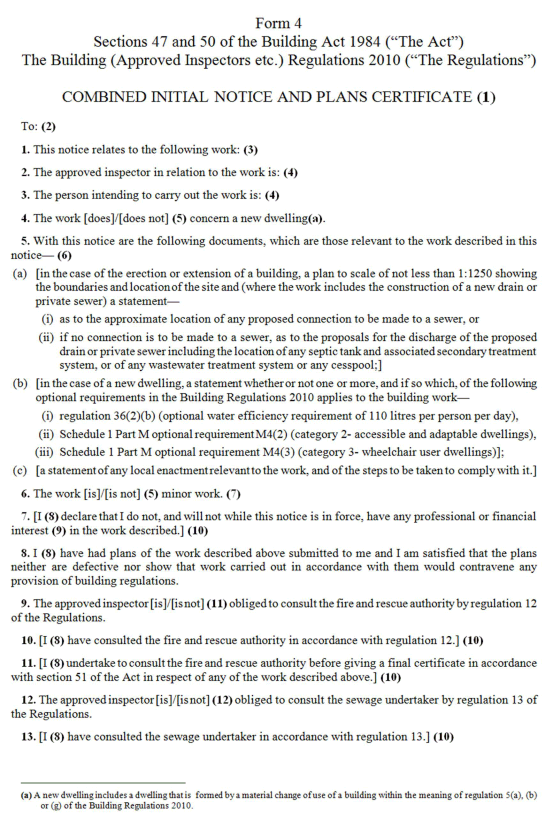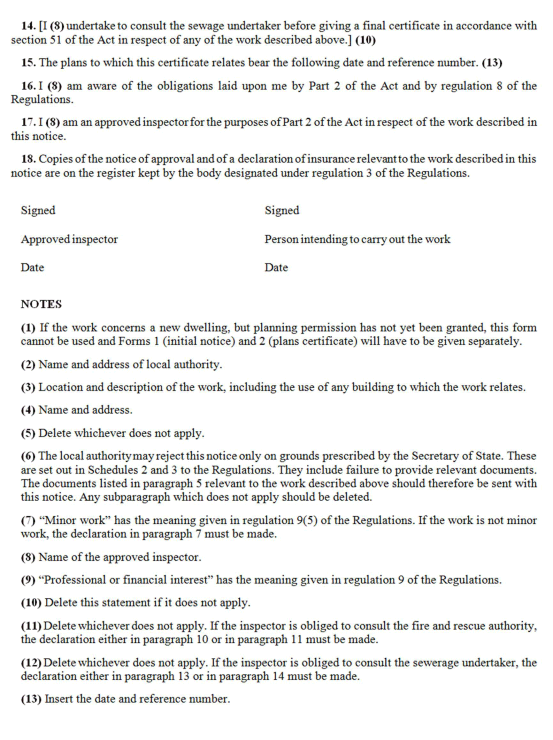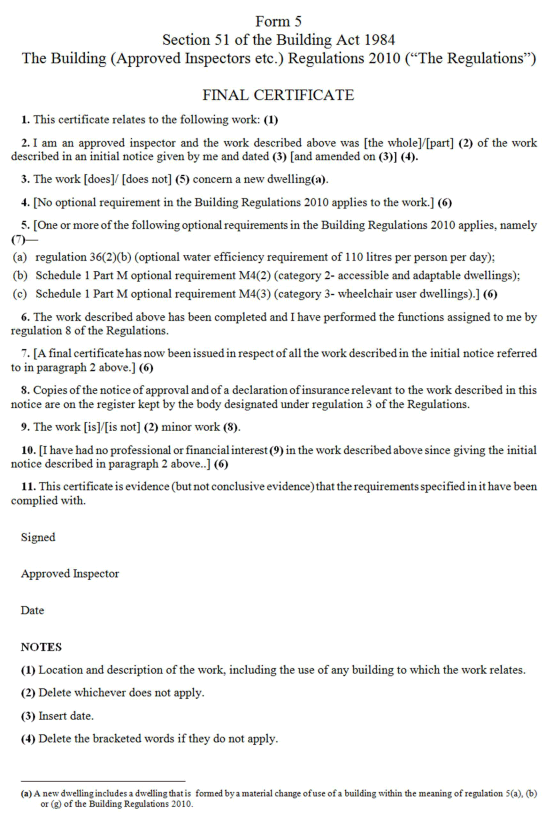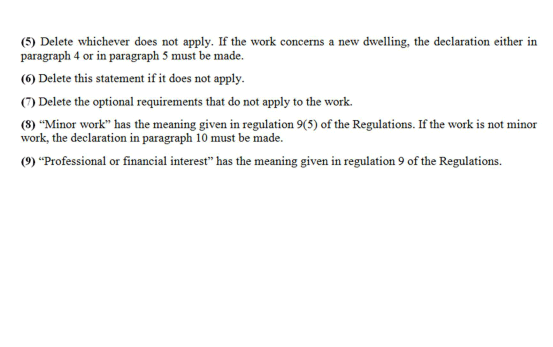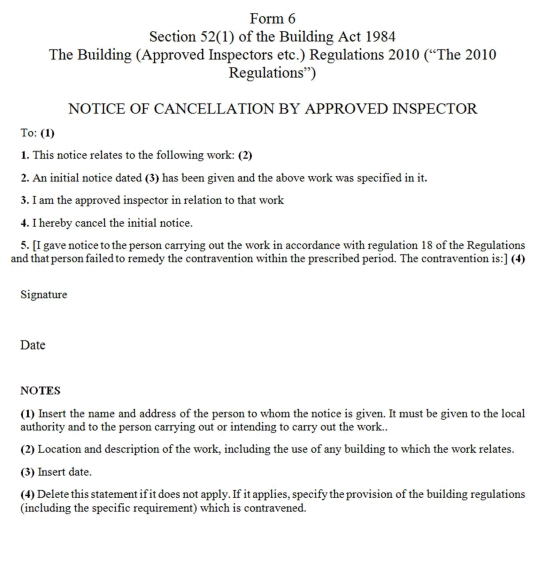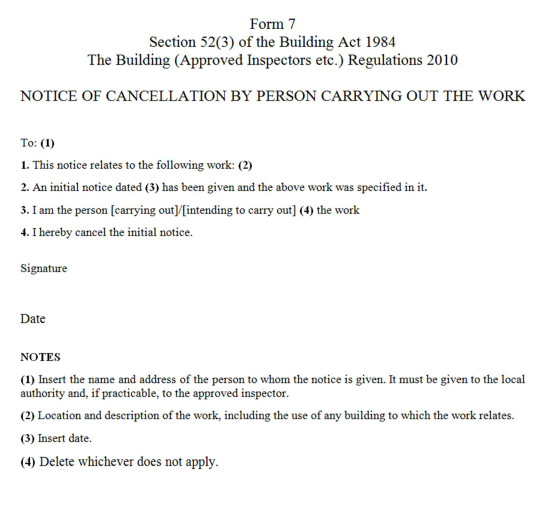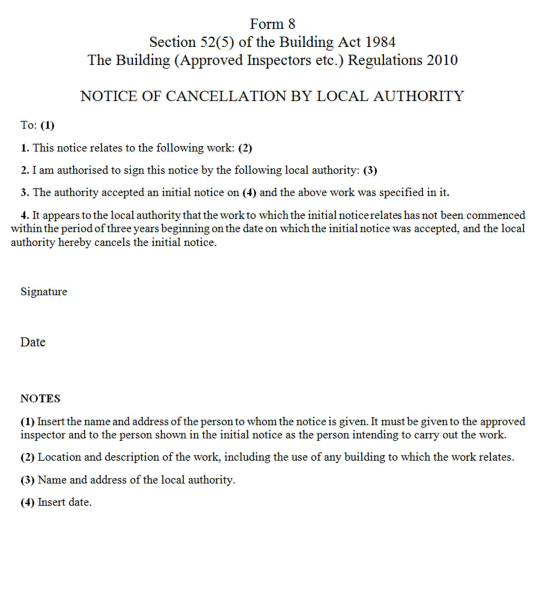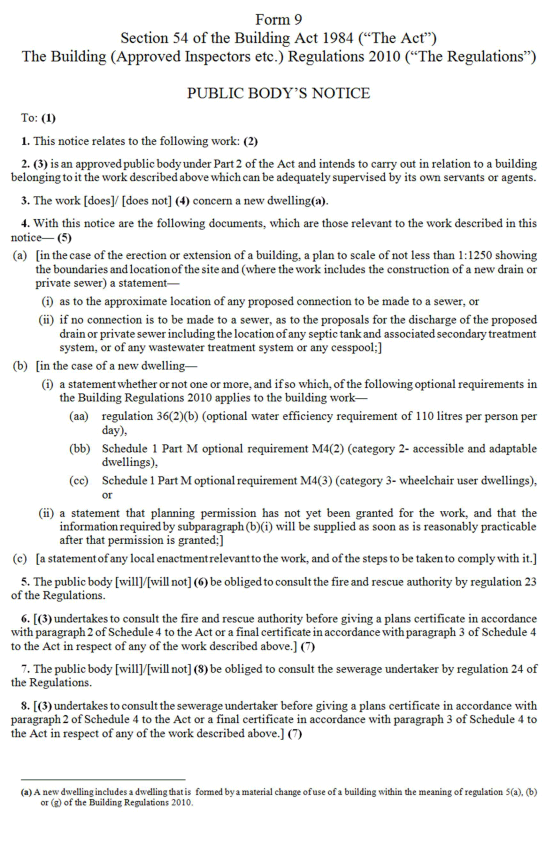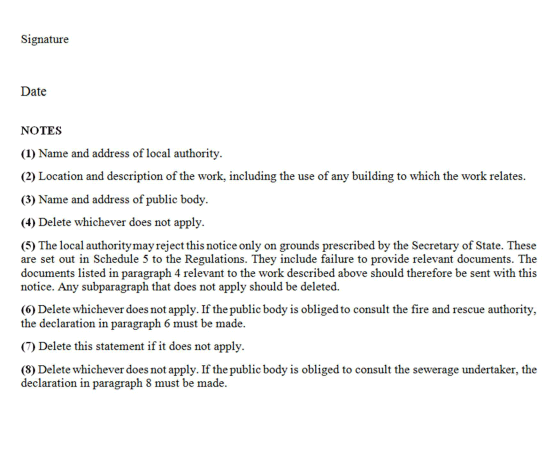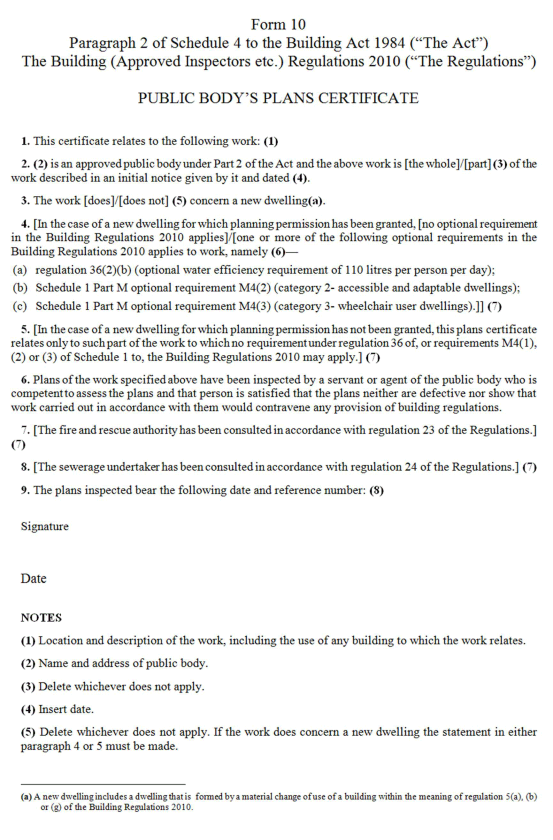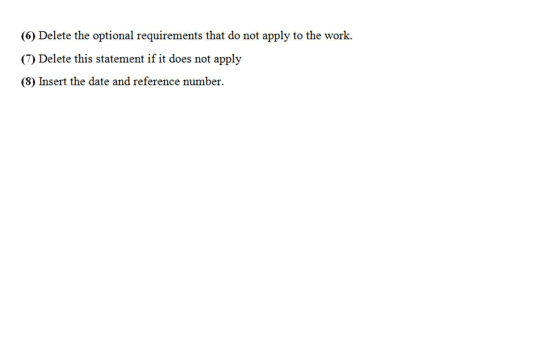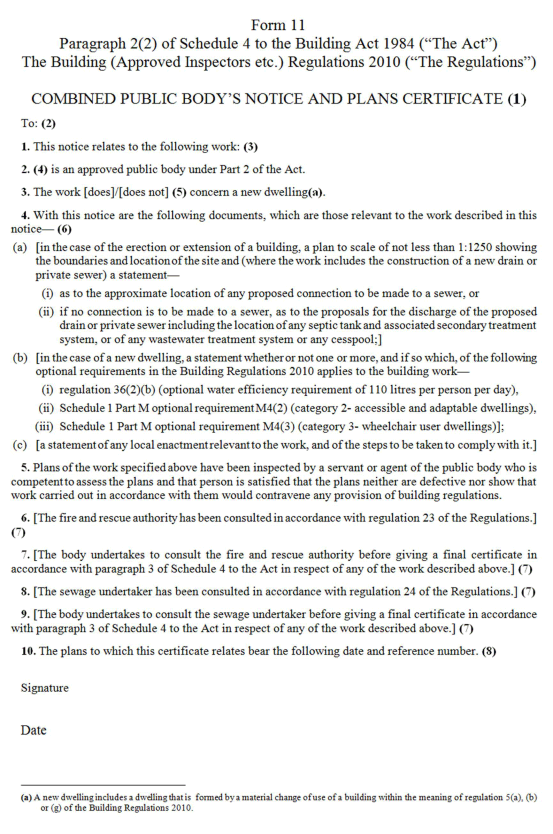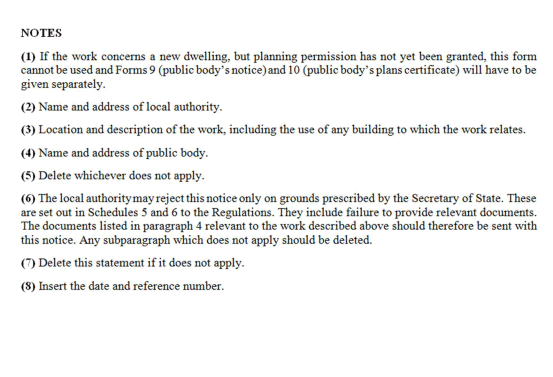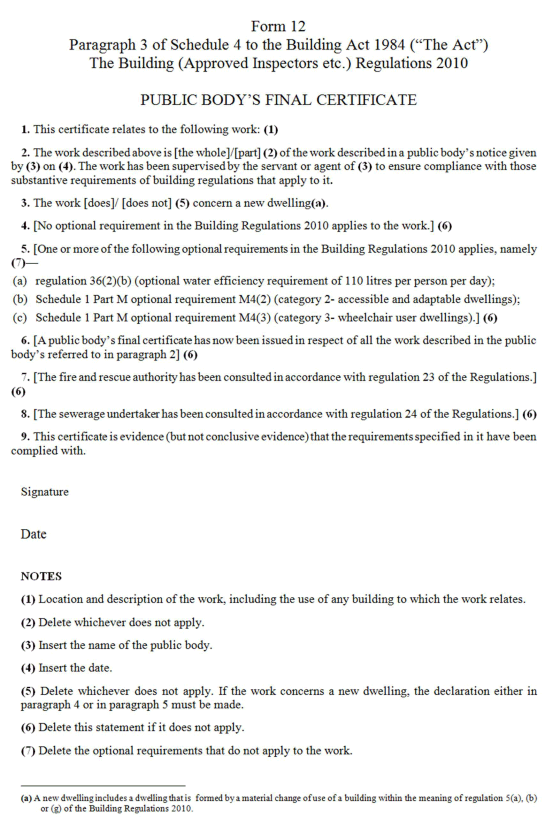The Building Regulations &c. (Amendment) Regulations 2015
Citation, extent, application and commencement
1.
(1)
These Regulations may be cited as the Building Regulations &c. (Amendment) Regulations 2015.
(2)
These Regulations extend to England and Wales.
(3)
(4)
These Regulations come into force on the following dates—
(a)
this regulation and regulation 2(10)(a) and (12) on 18th April 2015;
(b)
all remaining regulations, except regulation 2(10)(b), on 1st October 2015; and
(c)
regulation 2(10)(b) on 31st December 2015.
Amendments to the Building Regulations 2010
2.
(1)
(2)
In regulation 2(1) (interpretation)—
(a)
““new dwelling” includes, except in Parts 6 and 7, a dwelling that is formed by a material change of use of a building within the meaning of regulation 5(a), (b) or (g);
“optional requirement” means an optional requirement as described in regulation 4(1A)(b) or in regulation 36(2)(b);”; and
(b)
““planning permission” has the meaning given in section 336(1) (interpretation) of the Town and Country Planning Act 19905;”.
(3)
In regulation 4 (requirements relating to building work)—
(a)
in paragraph (1)(b) after “other such requirement” insert “, except as may be provided for in paragraphs (1C) and (1D)”;
(b)
“(1A)
The applicable requirements contained in Schedule 1 are—
(a)
the applicable requirements contained in Schedule 1 that apply in all cases, subject to paragraph (1C); and
(b)
any applicable requirement contained in Schedule 1, and described in the first column of that Schedule as an optional requirement, that applies in relation to the building work in question by virtue of paragraphs (1B), (1C) and (1D).
(1B)
An optional requirement as described in paragraph (1A)(b) shall apply to building work in any case where the planning permission under which the building work is carried out—
(a)
specifies that optional requirement by reference to these Regulations; and
(b)
makes it a condition that the requirement must be complied with.
(1C)
An optional requirement shall apply in substitution for a requirement of Schedule 1 to the extent that the terms of the optional requirement in the second column of Schedule 1 so provide.
(1D)
An optional requirement shall apply, and another optional requirement shall not apply, to the extent that the terms of the first-mentioned optional requirement in the second column of Schedule 1 so provide.”.
(4)
(a)
in subparagraph (1)(i) for “M1 (access and use)” substitute “M1 (access to and use of buildings other than dwellings)”;
(b)
“(j)
in the case of a material change of use described in regulation 5(a), (b) or (g), Q1 (security)”; and
(c)
in paragraph (2)—
(i)
after subparagraph (c) omit “and”, and
(ii)
“(e)
in a case to which subparagraph (j) applies in respect of a material change of use described in regulation 5(b) or (g), that part complies with the requirement referred to in that subparagraph;”.
(5)
In regulation 13 (particulars and plans where a building notice is given)—
(a)
in paragraph (1)—
(i)
after subparagraph (b) omit “and”, and
(ii)
“; and
(d)
in the case of a new dwelling—
(i)
a statement whether or not any optional requirement applies to the building work, and if so which, or
(ii)
a statement that planning permission has not yet been granted for the work, and that the information required by subparagraph (i) will be supplied before the end of a period of twenty eight days beginning on the day after that permission is granted”; and
(b)
“(1A)
In the case of a new dwelling, where a statement under paragraph (1)(d)(ii) has accompanied the building notice, a statement in the terms required by paragraph (1)(d)(i) must be provided to the local authority before the end of a period of twenty eight days beginning on the day after planning permission is granted for the building work, and the statement must state that it is supplementary to the information given in respect of the work pursuant to paragraph (1)(d).”.
(6)
In regulation 14(3)(a) (full plans) after “(1)” insert “, (1A)”.
(7)
(a)
after the definition “major renovation” omit “and”; and
(b)
““new dwelling” does not include a dwelling that is formed by a material change of use of a building”.
(8)
“(1)
The potential consumption of wholesome water by persons occupying a new dwelling must not exceed the requirement in paragraph (2).
(2)
The requirement referred to in paragraph (1) is either—
(a)
125 litres per person per day; or
(b)
in a case to which paragraph (3) applies, the optional requirement of 110 litres per person per day,
as measured in either case in accordance with a methodology approved by the Secretary of State.
(3)
This paragraph applies where the planning permission under which the building work is carried out—
(a)
specifies the optional requirement in paragraph (2)(b); and
(b)
makes it a condition that that requirement must be complied with.
(4)
In this Part, “new dwelling” does not include a dwelling that is formed by a material change of use of a building within the meaning of regulation 5(g).”.
(9)
“(1)
Where regulation 36 applies, the person carrying out the work must give the local authority a notice which specifies—
(a)
which of the requirements in regulation 36(2)(a) or (b) applies to the dwelling; and
(b)
the potential consumption of wholesome water per person per day in relation to the completed dwelling.”.
(10)
(a)
(b)
omit “the British Institute of Non-Destructive Testing,”.
(11)
(a)
in part H (drainage and waste disposal), in subparagraph (a) of the second column of requirement H3(2) (rainwater drainage)—
(i)
for “M1 (access and use), or” substitute “M1 (access to and use of buildings other than dwellings),”, and
(ii)
at the end of the subparagraph insert “, or requirement M4(1), (2) or (3) (access to and use of dwellings)”.
(b)
“PART M ACCESS TO AND USE OF BUILDINGS
Access to and use of buildings other than dwellings
M1. Reasonable provision must be made for people to—
(a) gain access to; and
(b) use, the building and its facilities.
Access to extensions to buildings other than dwellings
M2. Suitable independent access must be provided to the extension where reasonably practicable.
Sanitary conveniences in extensions to buildings other than dwellings
M3. If sanitary conveniences are provided in any building that is to be extended, reasonable provision shall be made within the extension for sanitary conveniences.
Access to and use of dwellings
Category 1- visitable dwelling
M4(1). Reasonable provision must be made for people to—
(a) gain access to; and
(b) use, the dwelling and its facilities
Category 2- accessible and adaptable dwellings
M4(2) optional requirement
(1) Reasonable provision must be made for people to—
(a) gain access to; and
(b) use, the dwelling and its facilities.
(2) The provision made must be sufficient to—
(a) meet the needs of occupants with differing needs, including some older or disabled people; and
(b) to allow adaptation of the dwelling to meet the changing needs of occupants over time.
Category 3- wheelchair user dwellings
M4(3) optional requirement
(1) Reasonable provision must be made for people to—
(a) gain access to; and
(b) use, the dwelling and its facilities.
(2) The provision made must be sufficient to—
(a) allow simple adaptation of the dwelling to meet the needs of occupants who use wheelchairs; or
(b) meet the needs of occupants who use wheelchairs.
Requirement M1 does not apply to
any part of a building that is used solely to enable the building or any service or fitting in the building to be inspected, repaired or maintained.
Requirement M2 does not apply where suitable access to the extension is provided through the building that is extended.
Requirement M3 does not apply where there is reasonable provision for sanitary conveniences elsewhere in the building, such that people occupied in, or otherwise having occasion to enter the extension, can gain access to and use those sanitary conveniences.
Requirement M4(1) does not apply to:
(a) an extension to a dwelling; or
(b) any part of a building that is used solely to enable the building or any service or fitting in the building to be inspected, repaired or maintained.
Optional requirement M4(2)—
(a) may apply only in relation to a dwelling that is erected;
(b) will apply in substitution for requirement M4(1);
(c) does not apply where optional requirement M4(3) applies;
(d) does not apply to any part of a building that is used solely to enable the building or any service or fitting in the building to be inspected, repaired or maintained.
Optional requirement M4(3)—
(a) may apply only in relation to a dwelling that is erected;
(b) will apply in substitution for requirement M4(1);
(c) does not apply where optional requirement M4(2) applies;
(d) does not apply to any part of a building that is used solely to enable the building or any service or fitting in the building to be inspected, repaired or maintained.
Optional requirement M4(3)(2)(b) applies only where the planning permission under which the building work is carried out specifies that it shall be complied with.”
(c)
“PART Q SECURITY
Unauthorised access
Q1
Reasonable provision must be made to resist unauthorised access to—
(a) any dwelling; and
(b) any part of a building from which access can be gained to a flat within the building.
Requirement Q1 applies only in relation to new dwellings.”
(12)
Amendments to the Building (Approved Inspectors etc.) Regulations 2010
3.
(1)
(2)
““new dwelling” includes a dwelling that is formed by a material change of use of a building within the meaning of regulation 5(a), (b) or (g) of the Principal Regulations;
“optional requirement” has the meaning given in regulation 2(1) of the Principal Regulations;”.
(3)
(4)
“(c)
information whether or not the work concerns a new dwelling;
(d)
in the case of an initial notice or an amendment notice in relation to a new dwelling, either—
(i)
a statement whether or not one or more, and if so which, of the following optional requirements applies to the building work—
(aa)
regulation 36(2)(b) (optional water efficiency requirement of 110 litres per person per day),
(bb)
Schedule 1 Part M optional requirement M4(2) (category 2- accessible and adaptable dwellings),
(cc)
Schedule 1 Part M optional requirement M4(3) (category 3- wheelchair user dwellings), or
(ii)
a statement that planning permission has not yet been granted for the work, and that the information required by subparagraph (i) will be supplied as soon as is reasonably practicable after that permission is granted;
(e)
in the case of a plans certificate combined with an initial notice, a statement in accordance with subparagraph (d)(i)”.
(5)
“Optional requirements2A.
The certificate does not contain—
(a)
information whether or not the work concerns a new dwelling; or
(b)
in the case of a new dwelling, information whether or not one or more, and if so which, of the following optional requirements applies to the building work—
(i)
regulation 36(2)(b) (optional water efficiency requirement of 110 litres per person per day),
(ii)
Schedule 1 Part M optional requirement M4(2) (category 2- accessible and adaptable dwellings),
(iii)
Schedule 1 Part M optional requirement M4(3) (category 3- wheelchair user dwellings); or
(c)
in the case of a plans certificate relating to a new dwelling, a statement that it relates only to such part of the work to which no requirement under regulation 36 of, or requirements M4(1), (2) or (3) of Schedule 1 to, the Building Regulations 2010 may apply.”.
(6)
“Optional requirements2A.
The certificate does not contain information—
(a)
whether or not the work concerns a new dwelling; or
(b)
in the case of a new dwelling, information whether or not one or more, and if so which, of the following optional requirements applies to the building work—
(i)
regulation 36(2)(b) (optional water efficiency requirement of 110 litres per person per day),
(ii)
Schedule 1 Part M optional requirement M4(2) (category 2- accessible and adaptable dwellings),
(iii)
Schedule 1 Part M optional requirement M4(3) (category 3- wheelchair user dwellings).”.
(7)
“(c)
information whether or not the work concerns a new dwelling;
(d)
in the case of a public body’s notice in relation to a new dwelling, either—
(i)
a statement whether or not one or more, and if so which, of the following optional requirements applies to the building work—
(aa)
regulation 36(2)(b) (optional water efficiency requirement of 110 litres per person per day),
(bb)
Schedule 1 Part M optional requirement M4(2) (category 2- accessible and adaptable dwellings),
(cc)
Schedule 1 Part M optional requirement M4(3) (category 3- wheelchair user dwellings), or
(ii)
a statement that planning permission has not yet been granted for the work, and that the information required by subparagraph (i) will be supplied as soon as is reasonably practicable after that permission is granted;
(e)
in the case of a combined public body’s notice and plans certificate, a statement in accordance with subparagraph (d)(i) ”.
(8)
“Optional requirements2A.
The certificate does not contain—
(a)
information whether or not the work concerns a new dwelling; or
(b)
in the case of a new dwelling, information whether or not one or more, and if so which, of the following optional requirements applies to the building work—
(i)
regulation 36(2)(b) (optional water efficiency requirement of 110 litres per person per day),
(ii)
Schedule 1 Part M optional requirement M4(2) (category 2- accessible and adaptable dwellings),
(iii)
Schedule 1 Part M optional requirement M4(3) (category 3- wheelchair user dwellings); or
(c)
in the case of a public body’s plans certificate relating to a new dwelling, a statement that it relates only to such part of the work to which no requirement under regulation 36 of, or requirements M4(1), (2) or (3) of Schedule 1 to, the Building Regulations 2010 may apply.”.
(9)
“Optional requirements2A.
The certificate does not contain information—
(a)
whether or not the work concerns a new dwelling; or
(b)
in the case of a new dwelling, information whether or not one or more, and if so which, of the following optional requirements applies to the building work—
(i)
regulation 36(2)(b) (optional water efficiency requirement of 110 litres per person per day),
(ii)
Schedule 1 Part M optional requirement M4(2) (category 2- accessible and adaptable dwellings),
(iii)
Schedule 1 Part M optional requirement M4(3) (category 3- wheelchair user dwellings).”.
Transitional provisions
4.
Regulations 2(3), (5), (6), (8), (9), and (11)(a) and (b), and 3(3) to (9) shall not apply in relation to building work in respect of which a building notice, an initial notice, a plans certificate, an amendment notice or a public body’s notice has been given to, or full plans deposited with, a local authority before 1st October 2015.
5.
Regulation 2(4) and (11)(c) shall not apply in relation to building work that is started before 1st October 2016 in respect of which a building notice, an initial notice, a plans certificate, an amendment notice or a public body’s notice has been given to, or full plans deposited with, a local authority before 1st October 2015.
Signed by authority of the Secretary of State for Communities and Local Government
SCHEDULE 1
“Column 1
Type of work
Column 2
Person carrying out work
1. Installation of a heat-producing gas appliance. This paragraph does not apply to the provision of a masonry chimney.
2. Installation of—
(a) an oil-fired combustion appliance; or
(b) oil storage tanks and the pipes connecting them to combustion appliances. This paragraph does not apply to the provision of a masonry chimney.
3. Installation of a solid fuel-burning combustion appliance other than a biomass appliance. This paragraph does not apply to the provision of a masonry chimney.
A person registered in respect of that type of work by Association of Plumbing and Heating Contractors (Certification) Limited, Building Engineering Services Competence Assessment Limited, Certsure LLP, HETAS Limited, NAPIT Registration Limited, Oil Firing Technical Association Limited, or Stroma Certification Limited.
4. Installation of a heating or hot water system, or its associated controls.
A person, or an employee of a person, who is a member of a class of persons approved in accordance with regulation 3 of the Gas Safety (Installation and Use) Regulations 1998, or a person registered in respect of that type of work by Association of Plumbing and Heating Contractors (Certification) Limited, Benchmark Certification Limited, Blue Flame Certification Limited, Building Engineering Services Competence Assessment Limited, Certsure LLP, HETAS Limited, NAPIT Registration Limited, Oil Firing Technical Association Limited, or Stroma Certification Limited.
5. Installation of a mechanical ventilation or air conditioning system or associated controls, in a building other than a dwelling, that does not involve work on a system shared with parts of the building occupied separately.
A person registered in respect of that type of work by Blue Flame Certification Limited, Building Engineering Services Competence Assessment Limited, Certsure LLP, NAPIT Registration Limited, or Stroma Certification Limited.
6. Installation of an air conditioning or ventilation system in a dwelling, that does not involve work on a system shared with other dwellings.
A person registered in respect of that type of work by Blue Flame Certification Limited, Building Engineering Services Competence Assessment Limited, Certsure LLP, NAPIT Registration Limited, or Stroma Certification Limited.
7. Installation of an energy efficient lighting system or electric heating system, or associated electrical controls, in buildings other than dwellings.
A person registered in respect of that type of work by Blue Flame Certification Limited, Building Engineering Services Competence Assessment Limited, Certsure LLP, NAPIT Registration Limited, or Stroma Certification Limited.
8. Installation of fixed low or extra-low voltage electrical installations in dwellings.
9. Installation of fixed low or extra-low voltage electrical installations in dwellings, as a necessary adjunct to or arising out of other work being carried out by the registered person.
A person registered in respect of that type of work by Association of Plumbing and Heating Contractors (Certification) Limited, Benchmark Certification Limited, Blue Flame Certification Limited, Building Engineering Services Competence Assessment Limited, Certsure LLP, NAPIT Registration Limited, or Stroma Certification Limited.
10. Installation, as a replacement, of a window, rooflight, roof window or door in an existing dwelling.
11. Installation, as a replacement, of a window, rooflight, roof window or door in an existing building other than a dwelling. This paragraph does not apply to glass which is load bearing or structural or which forms part of glazed curtain walling or a revolving door.
A person registered in respect of that type of work by BM Trada Certification Limited, Blue Flame Certification Limited, CERTASS Limited, Certsure LLP, by Fensa Limited under the Fenestration Self-Assessment Scheme, by NAPIT Registration Limited, Network VEKA Limited, or Stroma Certification Limited.
12. Installation of a sanitary convenience, sink, washbasin, bidet, fixed bath, shower or bathroom in a dwelling, that does not involve work on shared or underground drainage.
A person registered in respect of that type of work by Association of Plumbing and Heating Contractors (Certification) Limited, Benchmark Certification Limited, Building Engineering Services Competence Assessment Limited, Certsure LLP, HETAS Limited, NAPIT Registration Limited, or Stroma Certification Limited.
13. Installation of a wholesome cold water supply or a softened wholesome cold water supply.
A person registered in respect of that type of work by Association of Plumbing and Heating Contractors (Certification) Limited, Benchmark Certification Limited, Building Engineering Services Competence Assessment Limited, Certsure LLP, HETAS Limited, NAPIT Registration Limited, or Stroma Certification Limited.
14. Installation of a supply of non-wholesome water to a sanitary convenience fitted with a flushing device, that does not involve work on shared or underground drainage.
A person registered in respect of that type of work by Association of Plumbing and Heating Contractors (Certification) Limited, Benchmark Certification Limited, Building Engineering Services Competence Assessment Limited, Certsure LLP, HETAS Limited, NAPIT Registration Limited, or Stroma Certification Limited.
15. Installation in a building of a system to produce electricity, heat or cooling—
(a) by microgeneration; or
(b) from renewable sources (as defined in Directive 2009/28/EC of the European Parliament and of the Council on the promotion of the use of energy from renewable sources31).A person registered in respect of that type of work by Association of Plumbing and Heating Contractors (Certification) Limited, Benchmark Certification Limited, Building Engineering Services Competence Assessment Limited, Certsure LLP, HETAS Limited, NAPIT Registration Limited, Oil Firing Technical Association Limited, or Stroma Certification Limited.
16. Installation, as a replacement, of the covering of a pitched or flat roof and work carried out by the registered person as a necessary adjunct to that installation. This paragraph does not apply to the installation of solar panels.
17. Insertion of insulating material into the cavity walls of an existing building.
18. Installation of insulating material to the internal walls of a building, not including the installation of flexible thermal linings.
19. Installation of insulating material to the external walls of a building, not including insulation of demountable-clad buildings.
A person registered in respect of that type of work by Blue Flame Certification Limited, British Board of Agrément, CERTASS Limited, Certsure LLP, NAPIT Registration Limited, or Stroma Certification Limited.
20. Installation of insulating material to the external and internal walls of a building (“hybrid insulation”), not including insulation of demountable-clad buildings, and not including the installation of flexible thermal linings.
A person registered in respect of that type of work by Blue Flame Certification Limited, British Board of Agrément, CERTASS Limited, Certsure LLP, NAPIT Registration Limited or Stroma Certification Limited.”
SCHEDULE 2Forms for substitution in Schedule 1 to the Building (Approved Inspectors etc.) Regulations 2010
Regulation 2 of these Regulations amends the Building Regulations 2010 (S.I. 2010/2214, as amended by S.I. 2011/1515, S.I. 2012/718, S.I. 2012/3119, S.I. 2013/181, S.I. 2013/1105, S.I. 2013/1959, S.I. 2014/579 and S.I. 2014/2362) (“the Building Regulations”).
Regulation 2(2) inserts definitions “new dwelling” and “optional requirement” in regulation 2(1) (interpretation).
Regulation 2(3) amends regulation 4 (meaning of building work) to provide for compliance with optional requirements, which will apply instead of a requirement that is applicable in all cases, in cases where compliance with the optional requirement is made a condition of the planning permission under which building work is carried out.
Regulation 2(4) amends regulation 6 (requirements relating to material change of use) to provide for compliance with the new Part Q (security) of Schedule 1 (requirements relating to building work), inserted by regulation 2(11)(c), in cases where a dwelling is formed as a result of a material change of use of a building.
Regulation 2(5) and (6) amends regulations 13 (particulars and plans where a building notice is given) and 14 (full plans) respectively to provide for the giving of information about optional requirements in notices and plans given to local authorities by persons carrying out building work in relation to new dwellings.
Regulation 2(7) inserts a definition “new dwelling” in regulation 36 (interpretation of Part 6- energy efficiency requirements) to distinguish it from the definition “new dwelling” inserted by regulation 2(2) of these Regulations.
Regulation 2(8) and (9) amends regulations 36 (water efficiency of new dwellings) and 37 (wholesome water consumption calculation) to provide for the introduction of an optional requirement for water efficiency in certain new dwellings.
Regulation 2(10) amends regulation 43(4) (pressure testing) in relation to the bodies who may certify compliance with that regulation.
Regulation 2(11)(b) substitutes a new Part M (access to and use of buildings) in Schedule 1 (requirements). This includes in Part M4 (access to and use of dwellings) two levels of optional requirement, M4(2) (accessible and adaptable dwellings) and M4(3) (wheelchair user dwellings) as alternatives to requirement M4(1) (access to and use of dwellings). Regulation 2(11)(a) makes an amendment to Part H (drainage and waste disposal) requirement H3(2) (rainwater drainage) consequential upon regulation 2(11)(b).
Regulation 2(11)(c) adds a new Part Q (security) to Schedule 1 (requirements relating to building work).
Regulation 2(12) and Schedule 1 substitute the Table in Schedule 3 (self-certification schemes and exemptions from requirement to give building notice or deposit full plans) with a revised and updated Table.
Regulation 3 of these Regulations amends the Building (Approved Inspectors etc.) Regulations 2010 ((S.I. 2010/2215, as amended by S.I. 2012/3119, S.I. 2013/1959 and S.I. 2014/579).
Regulation 3(2) inserts in regulation 2 (interpretation) two definitions “optional requirement”, by reference to the Building Regulations, and “new dwelling”.
Regulation 3(3) and Schedule 2 substitute the various forms in Schedule 1 (forms) relating to the giving to local authorities of building notices and plans certificates in respect of building work supervised by bodies other than local authorities with revised and updated forms that include requirements to give information concerning optional requirements in the case of new dwellings.
Regulation 3(4) to (9) amends Schedules 2 to 7 (grounds for rejection by a local authority of various forms in Schedule 1) in consequence of the new forms introduced by Schedule 2 to these Regulations.
Regulations 4 and 5 contain transitional provisions.
Three impact assessments of the effect that these Regulations will have on the costs to business and the public and voluntary sectors have been prepared: RPC14-CLG-2252: Housing Standards Review Implementation; RPC14-CLG-2276: Housing Standards Review Security Final Implementation; and RPC14-FT-CLG-2311: Authorisation of New and Extended Competent Person Schemes. These are annexed to the Explanatory Memorandum to these Regulations which is available alongside the Regulations on the website www.legislation.gov.uk.
